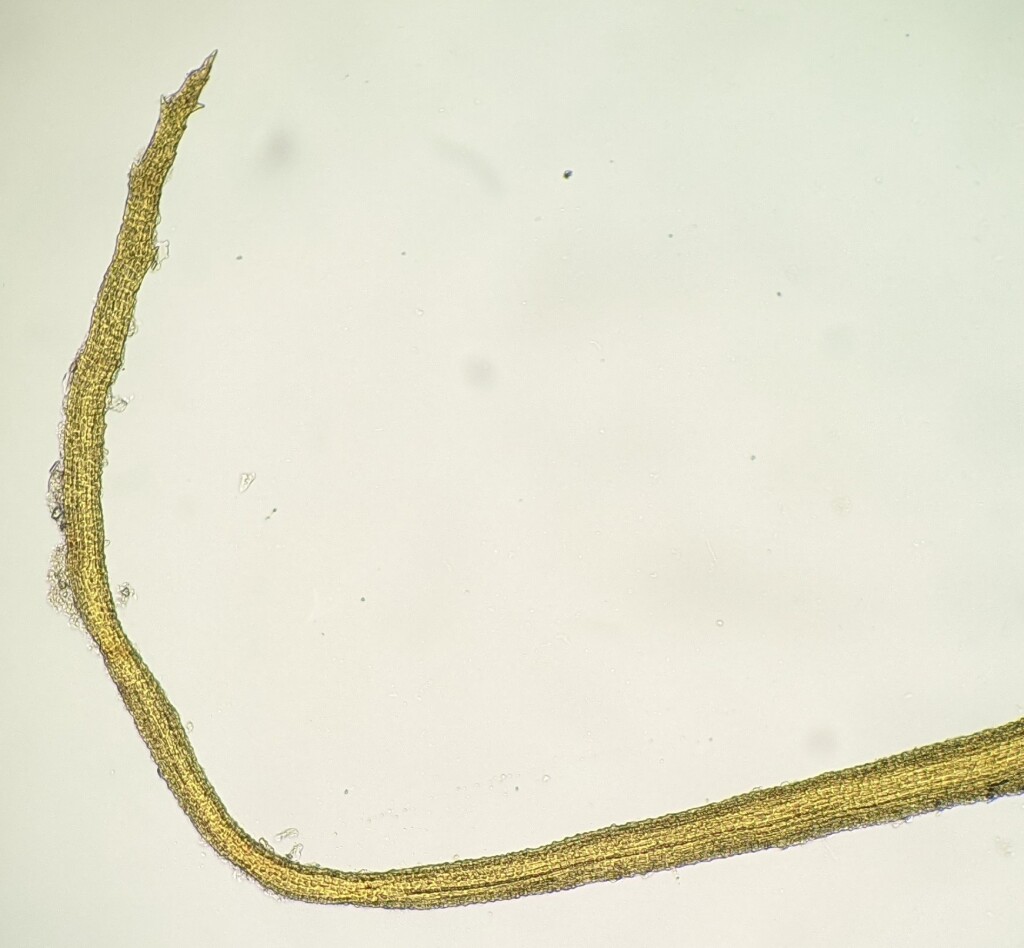Distichiaceae
Autoicous (not in Victoria), paroicous or synoicous (not in Victoria). Asexual propagules absent. Dense tufts on soil, rocks or rarely tree bases (not in Victoria). Stems simple or branched with rhizoids from base to middle of stem forming conspicuous tomentum; central strand present. Leaves distichous, monomorphic, subulate from a distinctly sheathing base; subula spreading and flexuosue when moist or dry; costa percurrent or shortly excurrent, occupying most of the subula, mamillose; margins plane to slightly incurved, denticulate in subula particularly near apices, without a border; laminal cells linear to oblong-linear or rectangular in sheathing base, quadrate to short-rectangular in subula, smooth. Acrocarpous. Capsules exserted, erect and symmetric or inclined and asymmetric, operculate. Calyptra cucullate, smooth, glabrous. Opercula rostrate from conic base. Peristome a single series of 16 teeth, entire (not in Victoria) or split into 2 (–3) terete filaments, sometimes with a rudimentary series outside and opposite the 16 teeth.
One cosmopolitan genus with 14 species; one species in Victoria.
The sole genus of this family, Distichium, has been included in the Ditrichaceae (e.g. Goffinet et al. 2009). However, in phylogenetic analyses of chloroplast DNA sequences, Distichium belongs to one of a few small lineages that diverge basally to a large group of mosses with a single series of peristome teeth, that comprises several families including the Ditrichaceae (La Farge et al. 2002; Hedderson et al. 2004; Fedosov et al. 2015, 2016). This placement is supported by its peristome structure that shows a transitional form from a double peristome to the typical single series, haplolepideous peristome type, comprised only of teeth equivalent to an endostome. In Distichium a reduced exostome that is opposite the endostome and extends up to a third of its length is present in some species, while in others, like the Victorian D. capillaceum (Hedw.) Bruch & Schimp., it is far more rudimentary when present (Fedosov et al. 2016). The gametophyte of Distichium is easily separated from the Ditrichaceae by its distichous leaf arrangement.
 Spinning
SpinningFedosov, V.E.; Fedorova, A.V.; Fedosov, A.E.; Ignatov, M.S. (2016). Phylogenetic inference and peristome evolution in haplolepidous mosses, focusing on Pseudoditrichaceae and Ditrichaceae s.l.. Botanical Journal of the Linnean Society 181: 139–155.
Fedosov, V.E.; Fedorova, A.V.; Ignatova, E.A.; Bobrova, V.K.; Troitsky, A.V. (2015). rps4 and nad5 sequences indicate the polyphyly of Ditrichaceae and parallelislms in the evolution of haplolepidous mosses. Molecular Biology 49: 890–894.
Goffinet, B.; Buck, W.R.; Shaw, A.J. (2009). Morphology, anatomy, and classification of the Bryophyta, in Goffinet, B & Shaw, A.J. (eds), Bryophyte Biology, 2nd edition, pp. 55–138. Cambridge University Press, Cambridge.
Hedderson, T.A.; Murray, D.J.; Cox, C.J.; Nowell, T.L. (2004). Phylogenetic relationships of haplolepideous mosses (Dicranidae) inferred from rps4 gene sequences. Systematic Botany 29: 29–41.
La Farge, C.; Shaw, A.J.; Vitt, D.H. (2002). The circumscription of the Dicranaceae (Bryopsida) based on the chloroplast regions trnL-trnF and rps4. Systematic Botany 27: 435–452.
